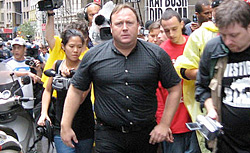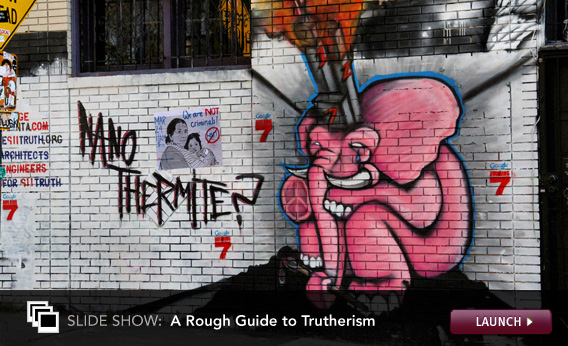Where Did 9/11 Conspiracies Come From?
The fringe.
The 9/11 conspiracy theories predate 9/11. On July 25, 2001, in a two-and-a-half-hour broadcast of his Infowars TV program on a local public-access channel, Alex Jones laid out what he saw as the history of government-manufactured false-flag attacks, from the Gulf of Tonkin incident that Lyndon Johnson used to draw the United States deeper into the Vietnam War to the first attack on the World Trade Center in 1993 and the Oklahoma City bombing in 1995, which Jones claimed was government-manufactured terrorism orchestrated to help Bill Clinton boost his poll numbers and suppress civil liberties. As he compared Oklahoma City to the Reichstag fire, Jones flashed the numbers for the congressional and White House switchboards onscreen. "Call the White House and tell them we know the government is planning terrorism," he said. " 'Bin Laden' "—he used air quotes—"is the boogeyman they need in this Orwellian phony system."
Six weeks later, on the day the Twin Towers fell, Jones began his broadcast by declaring that, as he had predicted, the Bush administration had taken part in a staged terror attack. "I'll tell you the bottom line," Jones said. "98 percent chance this was a government-orchestrated controlled bombing."
The controlled demolition theory remains the one great unifying dogma of 9/11 "truthers," as they call themselves. But immediately following the attacks, it was a difficult position to take. In the month after 9/11, Jones' steadfast preaching that 9/11 was an inside job cost him more than 70 of his 100-plus radio affiliates. Then again, his early stand would also lend him credibility when disenchantment from both the left and right steadily grew over the following decade. Now, Jones is back on more than 60 radio stations, with an all-time-high audience of 3 million listeners per day, and he boasts of his role in spreading the 9/11 conspiracy theory: "I am the progenitor of the entire enchilada."
But it was more than just enthusiastic "early adopters" that drove the popularity of the 9/11 conspiracy theory. Early facts—seemingly inconsequential nuggets passed around the Web soon after the attacks occurred—also played a major role. By the time these facts were debunked, the theory they were adduced to support had already gained widespread acceptance.
The first noticeable road sign as you enter Sebastapol, Calif., a small town two hours north of San Francisco, is for the city's fortune teller. Driving along the main drag one is similarly struck by rows of crunchy, hippie organic shops and advertisements for an interactive dinner murder mystery. It's almost cliché that down a winding back road in such a place lives another founder of the 9/11 conspiracy theory, Michael Ruppert. But much about Ruppert fits the stereotype of the full-time conspiracy theorist.
When I arrive at his two-acre country property, Ruppert gives me the tour of his personal garden and chicken coop, plucking an organic raspberry, a piece of lettuce, and a leaf of basil as a welcome offering. His upstairs hallway and office are adorned with photos of fellow conspiracy theorists such as Cynthia McKinney, the former Democratic member of Congress and 2008 Green Party presidential candidate. Ruppert gained a minor degree of celebrity himself two years ago after writing and starring in the critically acclaimed documentary Collapse, about his current twin obsessions of economic crisis and peak oil. He boasts that the movie made him friends with Mel Gibson and Leonardo DiCaprio, and is also a proud marijuana user. ("I used to have a column in High Times!") He is prone to bizarre rants about having predicted the current economic crisis. "I am America's Aleksandr Solzhenitsyn," he tells me in a typical non sequitur. "I'm in a gulag. Not like he was, not physically. I'm in a gulag of invisibility. The United States government and the mainstream media do not dare mention my name. I predicted all of these events, not all, but most of them, with alarming clarity."
Before 9/11, Ruppert had been working on other conspiracy theories—about a government supercomputer program, about accusations that AIG was laundering drug money, about alleged drug-running by the CIA. He had been obsessed with the CIA and drugs ever since he says the agency tried to recruit him through his ex-fiancee, "Teddy," while he was an LAPD narcotics officer in 1976. The dramatic tale of his descent from up-and-coming cop into career paranoiac is told in Jonathan Kay's chapter on the psychology of conspiracists in his book Among the Truthers: "Within two years of meeting 'Teddy,' Ruppert checked himself into a psychiatric hospital, complaining about death threats. Soon thereafter, he left the LAPD, and began peddling different versions of his story—including the contention that the CIA tried to recruit him to protect its L.A.-area drug operations—to whatever credulous journalists would listen." It was Ruppert's website From the Wilderness that was one of the first to start questioning the official account of 9/11.
On the morning of 9/11, Ruppert was exchanging emails with his ex-wife, who witnessed the attacks from her 35th floor Battery Park apartment. As Ruppert attempted to hold her hand virtually while she watched the North Tower burn, he watched live on TV as the second plane struck the South Tower.
"As soon as the second plane hit, I knew that this was totally wrong," he told me. "I may not have reported it right away, but I was in full investigative mode from the second I saw the second airplane hit the tower." And when the Pentagon was struck by Flight 77, it was all the confirmation Ruppert needed that the government had been complicit.
Ruppert then interrupts his story to show me a closet that houses his knife collection and "personal emergency survival supplies." He pulls out a framed photo of an Air Force pilot alongside assorted combat medals and ribbons. "This is my father," he says. "He was a radar intercept officer in F-89 and F-90 interceptors stationed in Alaska waiting for the Russian bombers to come over the pole. … I was raised into this culture. It's impossible under NORAD and Air Force scramble procedures for that plane to have ever hit the Pentagon. We were prepared for that from the 1950s."
For Ruppert, it was inconceivable that the most expensive air defense system in the world could possibly have failed that day. Never mind that it was a system whose primary mission was to guard against Soviet encroachment for 40 years and which continued to focus exclusively on external threats in the decade following the end of the Cold War. It should have been ready, and if it wasn't, then it had to be because of internal sabotage.
Lending credence to this conspiracy, the official timeline issued by military commanders in the wake of the attacks was incorrect. At first NORAD claimed that fighters were notified that Flight 77 was hijacked, and that the fighters were scrambled toward Washington in what should have been enough time to intercept the third plane before it struck the Pentagon. Eventually, using subpoena power, the 9/11 Commission was able to piece together the actual timeline of events that day, which demonstrated that contrary to previous claims, the military had not been aware of any of the hijackings before it was much too late. Though military officials were exonerated of intentionally misleading the 9/11 Commission, some staff members of the commission would later go on to describe the testimony as deliberately untrue.
So the seed of one key 9/11 conspiracy theory was based on a government-propagated falsehood. The tapes of the day's events from NORAD's Northeast headquarters, eventually released to the public in 2007, would prove that there was little the fighters could have done. But by then it didn't matter. As early as November 2001, Ruppert was lecturing in front of 1,000 people at Portland State University on the "Truth and Lies of 9/11," which he recorded and soon started marketing. He went on to catalog his From the Wilderness reports into a book, Crossing the Rubicon: The Decline of the American Empire at the End of the Age of Oil, which has sold more than 100,000 copies.
***
In the weeks and months after 9/11, Jones and Ruppert were already formulating a vast conspiracy theory that would take several years to reach peak popularity. There was another theory, however, that spread more widely and died more quickly, at least in the West. As such, it serves as a lesson in how and where—if not why—conspiracy theories work: by taking a small nugget of truth and constructing entire mythologies around it.
It took less than 24 hours for vague theories attributing the attacks to Israel to begin to circulate. Four days after 9/11, the first piece of evidence linking Israel to the attacks was reported in Syrian newspaper Al Thawra. The government paper stated that "4,000 Jews were absent from their work on the day of the explosions," the implication being that 4,000 Jews were forewarned about the attacks by the actual plotters, fellow Jews. The story spread through the Middle East. The original source of that precise 4,000 number was the Jerusalem Post, which reported on the day of the attacks that "[t]he Foreign Ministry in Jerusalem has so far received the names of 4,000 Israelis believed to have been in the areas of the World Trade Center and the Pentagon at the time of the attacks."
Slate and popular myth-busting site Snopes.com were two of the first outlets to debunk the rumor. Yet 10 years later, morphed versions of the discredited "Jewish foreknowledge" stories are still being repeated by fringe anti-Semitic 9/11 conspiracy theorists, including Iranian President Mahmoud Ahmadinejad. The theory does not have much traction in America, even among 9/11 conspiracy theorists, but it has maintained consistent popularity on the Arab street, where according to the New York Times it is conventional wisdom that Jews were warned to stay home that day.
A 2008 World Public Opinion poll showed that 43 percent of Egyptian respondents blamed Israel for 9/11, while 31 percent in Jordan blamed Israel, and 36 percent in Turkey pinned the attacks on the United States government. In the Palestinian territories, 27 percent thought the United States was responsible, while 19 percent said Israel had carried out the attacks. Arabic editions of the original anti-Semitic conspiracy theory, The Protocols of the Elders of Zion, have been best-sellers in Syria and Lebanon, while the famous forgery was adapted for Egyptian television in a 41-part "historical drama" in 2002.
In the Middle East, says Charles Hill, a 32-year veteran of the foreign service, there is a deep undercurrent of belief that just about everything that happens in the world—good and bad—is due to an American-led international Jewish conspiracy. "America is kind of Jewry writ-large because 'the Jews control the media, they control committees of Congress, and they control the universities,' and such," he says. In the case of the 4,000-Jews rumor, Hill says, the very specificity of the charge lent it credibility—even as it also allowed it to be quickly debunked. Conspiracists like a fact "that is concocted to be plausible because it is highly specific," Hill says. "And because it is highly specific, and because it has been, they claim, discovered, because it had been covered up, designed not to be known, and it was revealed by an error or by someone who stumbled across it, and therefore that proves or adds credibility to the overall charge."
***
The prominence of the 4,000-Jews rumor in the Middle East to this day and its failure to catch on in the United States is illustrative of a crucial fact of the popularity of conspiracy theories: They need fertile ground in order to flourish. In the early days after 9/11 in the United States, the fields were relatively fallow. But within 18 months of 9/11, that would begin to change.
Part 2: The rise of 9/11 conspiracism.

